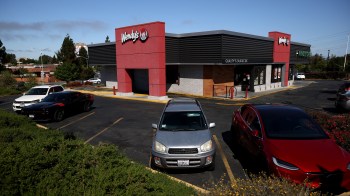Kai Ryssdal: Our coverage of the economic legacy of September 11th takes a turn to technology today, and the law of unintended consequences. Not long after the attacks, the federal government began investing heavily in new technologies that Washington said would make us safer as individuals and more secure as a nation. One of those technologies was facial recognition research. Back then, it sounded futuristic or something out of James Bond. And then Facebook happened.
Marketplace’s Steve Henn reports.
Steve Henn: A couple weeks ago at a conference in Las Vegas, a professor from Carnegie Mellon University named Alessandro Acquisti showed me a neat trick. He takes out his iPhone and boots up a custom-made app. It’s designed to take a picture of a person — any person — then using a facial recognition program made by PittPatt, the app compares that picture to profile photos published on Facebook. And bingo — the person’s identity is revealed.
Henn: Can you take my picture and see if you can identify me?
Alessandro Acquisti: Ah, we can try.
Henn: Yeah.
Sixty seconds later, Acquisti’s iPhone has found me. It has my real name and a picture of me sitting with two of my kids on the stoop of my old house in Washington, D.C. It also had scanned the web and found a picture of me at cocktail party in Los Angeles, holding a martini, with my arm around a colleague. This picture actually got me in trouble with my mother-in-law.
Acquisti: The combination of these technologies is bringing us closer to a world where online and offline data merge.
And when the online and offline worlds merge…
Acquisti: The consequences can be cool, but also very creepy.
The app’s creepiest trick comes next: It delivers its best guess at my Social Security number. In my case, it gets the number wrong. But if the app can figure out where you’re born from scanning your Facebook page, it has a good shot of getting the number right.
So how did we end up here?
Fred Cate is a law professor and privacy guru at Indiana University. He says after 9/11, two independent trends dovetailed and reinforced each other. The federal government was investing hundreds of millions in surveillance technology and research to try and keep us safer. And companies like Google and Facebook were remaking the digital landscape. There was a data-collecting revolution.
Fred Cate: 9/11 and the sort of huge growth in social networking and in profiling and collecting Internet traffic — those events are really parallel with each other.
And Cate says:
Fred Cate: We have gotten more used to more surveillance. And it’s not clear that that’s just attributable to the events of 9/11. But particularly when you think of the types of security we all go through now — would have been pretty close to unthinkable a decade ago.
And some of the technologies that make this world possible only work today because of 9/11. Just take a look a facial recognition — it’s one of the technologies that makes Acquisti’s app work — but 10 years ago, it didn’t work that well.
Michael Sipes is a vice president of PittPatt.
Michael Sipes: So the intelligence community funded the early development of the technology because they had a problem. They’re collecting information at a rate faster than they could process it and make use of it.
And facial recognition could help. Sipes’ company spun out of a Carnegie Mellon lab that received hundreds of thousands of dollars in funding from ARPA — the intelligence communities research arm. In this industry, that same basic story plays out again and again.
Prof. Allen Yang helped create another powerful facial recognition program that can recognize people even when they’re wearing glasses, masks or hats that cover some of their features.
Allen Yang: My research is funded by two grants — one is from the Army Research Office, another is from the other is the Army Research Lab.
These investments after 9/11 created breakthroughs. Here’s PittPatt’s Michal Sipes.
Sipes: The technology — the facial recognition technology — is just now really becoming reliable to become useful to a consumer.
And venture capitalists and tech giants noticed. Some of the most successful new companies in America today make their money collecting and analyzing data about us, and using it to create new services or tailor ads aimed at our individual whims.
Fred Cate says just imagine if you were a car dealer. You could hook Acquisti’s app up to your surveillance cameras, identify potential customers, then check their incomes and credit ratings while they wandered around your lot.
Cate: These technologies only succeed in the market because people love them.
Alessandro Acquisti has no plans to sell his app or make it public. In fact, the prospect of that horrifies him. But Cate thinks the commercial pressure to use technology like this will be intense. And some of the biggest companies in America agree. PittPatt was just bought by Google. But its technology only exists because of investments the government made in research in the wake of the attacks 10 years ago.
In Silicon Valley, I’m Steve Henn for Marketplace.
There’s a lot happening in the world. Through it all, Marketplace is here for you.
You rely on Marketplace to break down the world’s events and tell you how it affects you in a fact-based, approachable way. We rely on your financial support to keep making that possible.
Your donation today powers the independent journalism that you rely on. For just $5/month, you can help sustain Marketplace so we can keep reporting on the things that matter to you.


















